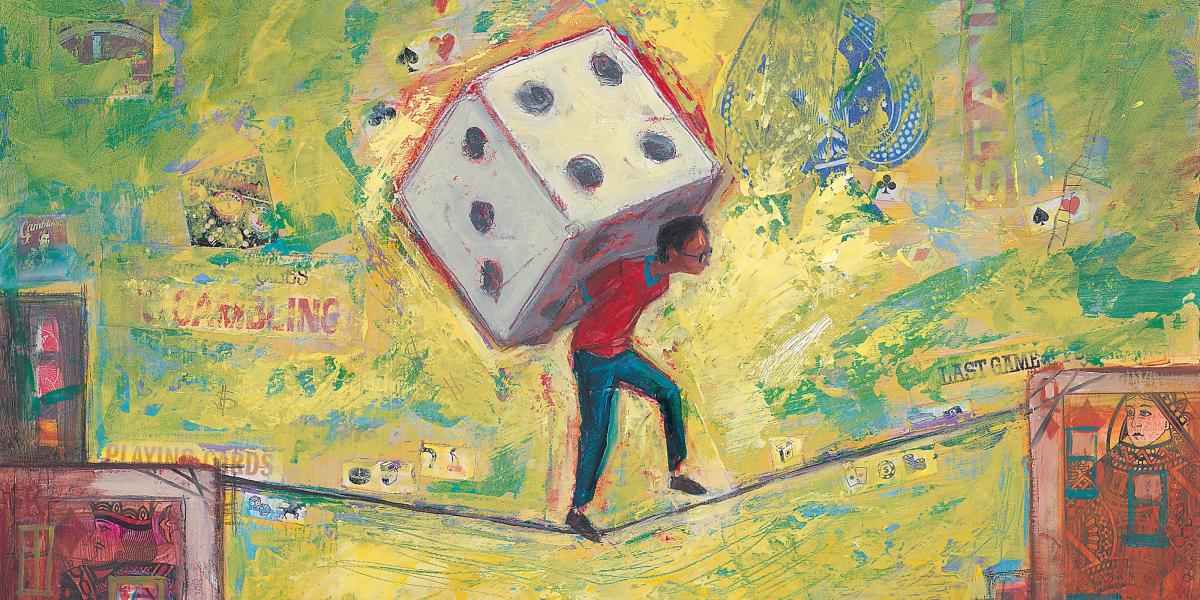Bad Odds for Youth Gamblers
You do it once, and then again, and soon it has you hooked. It pulls you away from family and friends. Ruins your ability to focus on school or productive work. Drives you into debt, desperation—even thievery. And as you spiral downhill, the brief rush that it gives you becomes your only solace.
“Problem gambling is like a drug addiction; the behavioral and health consequences are virtually the same. And what most people don’t realize is that it is much more common among adolescents than adults,” says Silvia S. Martins, MD, PhD, an epidemiological psychiatrist in Mental Health and senior author of two new studies of gambling behaviors among youths in West Baltimore.
With their still-developing forebrains, youths tend naturally to be more impulsive than adults, and to that extent are less resistant to addictive drugs and behaviors. Male youths, with their testosterone-driven culture of risk taking, seem particularly vulnerable. And what of youths in blighted inner-city neighborhoods? “No one had studied gambling behaviors in such a population before,” says Martins.
The Brazilian-born epidemiologist began her career with studies of problem gamblers in São Paulo. When she came to Hopkins to do postdoctoral research in 2003, she learned of an ongoing study in West Baltimore, headed by Mental Health Professor Nicholas Ialongo, PhD. Since 1993, researchers had been doing annual, school-based surveys of a single cohort of several hundred mostly African-American youths, and the study was designed among other things to highlight the childhood social and psychological antecedents of criminal and other undesired behaviors. Starting in 2004, when the youths in the cohort were about 17 years old, Martins and her colleagues added a standard gambling questionnaire known as the South Oaks Gambling Screen.
“Problem gambling is like a drug addiction; the behavioral and health consequences are virtually the same. Most people don’t realize that it is much more common among adolescents than adults.” —Silvia S. Martins
Gambling turned out to be the norm among the surveyed adolescents, especially the males, and “problem gambling”—a label that applied to about 12 percent of the sample—was much higher than the 1 to 3 percent normally observed in U.S. and Canadian adult populations. But the measured prevalence of gambling and problem gambling was not greatly different from what epidemiologists have seen in Caucasian adolescent populations. The types of gambling—card games, sports betting, lotteries, graduating to casino-type gambling as the youths grew up and could drive to Atlantic City, N.J.—also were similar to those seen in other studied populations. “If we had done that study with white suburban kids in Baltimore County, we probably would have seen the same kinds of gambling activities,” says Martins.
For the boy gamblers—the girl gamblers being too few to permit much analysis—the data suggested a link between problem gambling and very bad experiences in childhood. “We found that certain kinds of adverse events, such as being directly threatened, or being involved in violent or other criminal behavior, were associated with frequent gambling in later adolescence,” says Martins. These findings were published online in May of this year in the Journal of Gambling Studies, with Carla Storr, ScD, MPH, a professor at the University of Maryland School of Nursing, and an adjunct professor in the Bloomberg School’s Department of Mental Health, as first author.
In a related analysis, Martins and colleagues, including first author Grace Lee, MHS, a Mental Health doctoral student, found that signs of depression at age 12 were linked to a greater likelihood of problem gambling in late adolescence.
“This replicates some other research that shows that if you have a lot of problems in your life, your parents are divorced, or you’ve lost relationships or you’ve had a sibling who’s died or been shot, then that increases your stress level—and gambling may be used as a way of escaping that,” says Jeffrey L. Derevensky, PhD, of McGill University, an expert on gambling and other adolescent high-risk behaviors, and a co-author of the Storr study.
One lesson from this may be that, as Martins says, “public health practitioners need to be more aware that kids in these bad situations are not only at greater risk of using drugs and alcohol to alleviate their mental health or depressive symptoms, they also may be at greater risk of getting into problem gambling—and so we need to think about how we can intervene effectively in such situations.”
But adolescent problem gambling isn’t merely an adverse outcome; it also seems to be a reliable marker of other ongoing behaviors whose ill effects are apt to cascade into adulthood. “It can be seen as part of a problem-behavior syndrome in adolescence, with potential adverse consequences in later life from the lack of education because the gambler dropped out of school, has a criminal record and so on,” says Martins.
What makes the situation in Baltimore particularly worrisome is that the opportunities for urban youths to gamble are about to expand. In 2008, Marylanders voted for a referendum that would enhance state revenues by allowing slot machines in certain locations; and discussions are under way to build a slot-machine casino in the Inner Harbor. “Prior studies have shown that the closer you are to a casino, the more likely you will be to gamble,” Martins says. “And slot machines are widely considered the most addictive form of gambling.”
